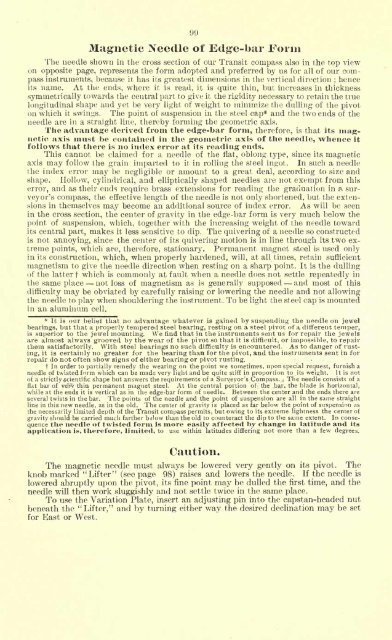STANDARD - Survey Instrument Antique Center!
STANDARD - Survey Instrument Antique Center!
STANDARD - Survey Instrument Antique Center!
You also want an ePaper? Increase the reach of your titles
YUMPU automatically turns print PDFs into web optimized ePapers that Google loves.
99<br />
Magnetic Needle of Edge-bar Form<br />
The needle shown in the cross section of our Transit compass also in the top view<br />
on opposite page, represents the form adopted and preferred by us for all of our com-<br />
pass instruments, because it has its greatest dimensions in the vertical direction hence<br />
;<br />
its name. At the ends, where it is read, it is quite thin, but increases in thickness<br />
symmetrically towards the central part to give it the rigidity necessary to retain the true<br />
longitudinal shape and yet be very light of weight to minimize the dulling of the pivot<br />
on which it swings. The point of suspension in the steel cap* and the two ends of the<br />
needle are in a straight line, thereby forming the geometric axis.<br />
The advantage derived from the edge-bar form, therefore, is that its magnetic<br />
axis must be contained in the geometric axis of the needle, whence it<br />
follows that there is no index error at its reading ends.<br />
This cannot be claimed for a needle of the flat, oblong type, since its magnetic<br />
axis may follow the grain imparted to it in rolling the steel ingot. In such a needle<br />
the index error may be negligible or amount to a great deal, according to size and<br />
shape. Hollow, cylindrical, and elliptically shaped needles are not exempt from this<br />
error, and as their ends require brass extensions for reading the graduation in a surveyor's<br />
compass, the effective length of the needle is not only shortened, but the extensions<br />
in themselves may become an additional source of index error. As will be seen<br />
in the cross section, the center of gravity in the edge-bar form is very much below the<br />
point of suspension, which, together with the increasing weight of the needle toward<br />
its central part, makes it less sensitive to dip. The quivering of a needle so constructed<br />
is not annoying, since the center of its quivering motion is in line through its two extreme<br />
points, which are, therefore, stationary. Permanent magnet steel is used only<br />
in its construction, which, when properly hardened, will, at all times, retain sufficient<br />
magnetism to give the needle direction when resting on a sharp point. It is the dulling<br />
of the latter t which is commonly at fault when a needle does not settle repeatedly in<br />
the same place not loss of magnetism as is generally supposed and most of this<br />
difficulty may be obviated by carefully raising or lowering the needle and not allowing<br />
the needle to play when shouldering the instrument. To be light the steel cap is mounted<br />
in an aluminum cell.<br />
* It is our belief that no advantage whatever is gained by suspending the needle on jewel<br />
bearings, but that a properly tempered steel bearing, resting on a steel pivot of a different temper,<br />
is superior to the jewel mounting. We find that in the instruments sent us for repair the jewels<br />
are almost always grooved by the wear of the pivot so that it is difficult, or impossible, to repair<br />
them satisfactorily. With steel bearings no such difficulty is encountered. As to danger of rusting,<br />
it is certainly no greater for the bearing than for the pivot, and the instruments sent in for<br />
repair do not often show signs of either bearing or pivot rusting.<br />
t In order to partially remedy the wearing on the point we sometimes, upon special request, furnish a<br />
needle of twisted form which can be made very Tight and be quite stiff in proportion to its weight. It is not<br />
of a strictly -scientific shape but answers the requirements of a <strong>Survey</strong>or's Compass. , ; The needle consists of a<br />
flat bar of ye 5<br />
thin permanent magnet steel. At the central portion of; the ,bar, the blade is horizontal,<br />
while at the ends it is vertical as in the edge-bar form of needle. Between the center and the ends there are<br />
several twists in the bar. The points of the needle and the point of suspension are all in the same straight<br />
line in this new needle, as in the old. The center of gravity is placed as far below the point of suspension as<br />
the necessarily limited depth of the Transit compass permits, but owing to its extreme lightness the center of<br />
gravity should be carried much farther bilow than the old to counteract the dip to the same extent. In consequence<br />
tlie needle of twisted form is more easily affected by change in latitude and its<br />
application is, therefore, limited, to use within latitudes differing not more than a few degrees.<br />
Caution.<br />
The magnetic needle must always be lowered very gently on its pivot. The<br />
knob marked "Lifter" (see page 98) raises and lowers the needle. If the needle is<br />
lowered abruptly upon the pivot, its fine point may be dulled the first time, and the<br />
needle will then work sluggishly and not settle twice in the same place.<br />
To use the Variation Plate, insert an adjusting pin into the capstan-headed nut<br />
beneath the "Lifter," and by turning either way the desired declination may be set<br />
for East or West.


